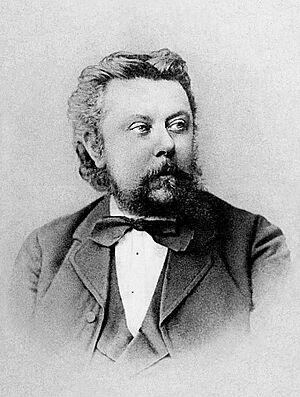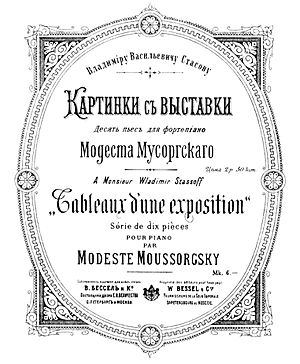Pictures at an Exhibition facts for kids
Pictures at an Exhibition is a famous piece of music for solo piano. It was written by Modest Mussorgsky in 1874. This is Mussorgsky’s most well-known piano work. It is often played by amazing musicians called virtuosos to show off their skills.
Many years after Mussorgsky died, a French composer named Maurice Ravel made a special version of the piece for an orchestra. This orchestral version also became very famous. Today, most people hear the music played by an orchestra.
Contents
How the Music Was Created

Pictures at an Exhibition is like a musical tour of an exhibition of paintings by an artist named Viktor Hartmann. Hartmann was a good friend of Mussorgsky. He died very young in 1873, at just 39 years old. Both Hartmann and Mussorgsky wanted their art to feel very Russian. Hartmann did this with his pictures, and Mussorgsky did it with his music.
In 1874, an exhibition of Hartmann’s pictures was held in St Petersburg. Mussorgsky visited the exhibition and felt inspired to write his piano piece. The music describes someone walking around the exhibition and looking at the pictures. The ten pictures he describes in music were drawings and watercolours.
Mussorgsky starts his piece with a tune that shows the person walking around. This tune is called the “promenade” theme. A promenade is just a walk. At first, Mussorgsky puts the promenade theme between each picture. But later in the piece, parts of the promenade theme appear within the music for the pictures themselves.
When the Music Was Published
Mussorgsky wrote Pictures at an Exhibition very quickly. However, it was not published until 1886, which was five years after he died. Mussorgsky’s good friend Nikolai Rimsky-Korsakov published it. But he made some changes to what Mussorgsky had originally written. It wasn't until 1931 that a version was published that tried to show exactly what Mussorgsky had intended.
What the Music Sounds Like
The Promenade theme describes a person walking around the art show. It has big, important-sounding chords. Mussorgsky wrote it with a special rhythm, but today it’s often written in a simpler way.
Here are the ten pictures that Mussorgsky describes in his music:
- No. 1 "Gnomus" : This music sounds like a little gnome with crooked legs trying to run. Hartmann’s drawing might have been a toy nutcracker.
- No. 2 "The Old Castle" describes an old medieval castle. You can almost hear a troubadour singing a gentle, sad song in front of it. In Ravel’s orchestra version, the alto saxophone plays this tune.
- No. 3 "Tuileries" describes children playing in a park in Paris called Tuileries. The music has a small tune that sounds like children singing a playful, teasing song.
- No. 4 "Bydło" describes a heavy cart being pulled by oxen. In Ravel’s orchestral version, the tuba plays the tune. It sounds very low and heavy, like the cart.
- No. 5 "The Ballet of the Unhatched Chicks" describes tiny canary chicks still inside their eggs. The picture was based on a ballet show from 1870.
- No. 6 "Samuel Goldenberg und Schmuÿle" describes two Jewish men. One is rich and the other is poor.
- No. 7 "The Market at Limoges" describes French women arguing in a busy market. Limoges is a city in central France.
- No. 8 "The Catacombs" describes the dark catacombs under Paris. The music uses loud and soft chords. You can hear the promenade theme again, but it sounds spooky and ghostly.
- No. 9 "The Hut on Hen’s Legs" is about a picture where Hartmann drew a clock that looks like Baba-Yaga's hut, which stands on hen’s legs.
- No. 10 "The Great Gate of Kiev" ("The Bogatyr Gates") was inspired by Hartmann's drawing for a huge gate. This gate was planned to remember how the Tsar survived an assassination attempt on April 4, 1866. The design won a prize, but the gate was never actually built.
Images for kids
See also
 In Spanish: Cuadros de una exposición para niños
In Spanish: Cuadros de una exposición para niños











